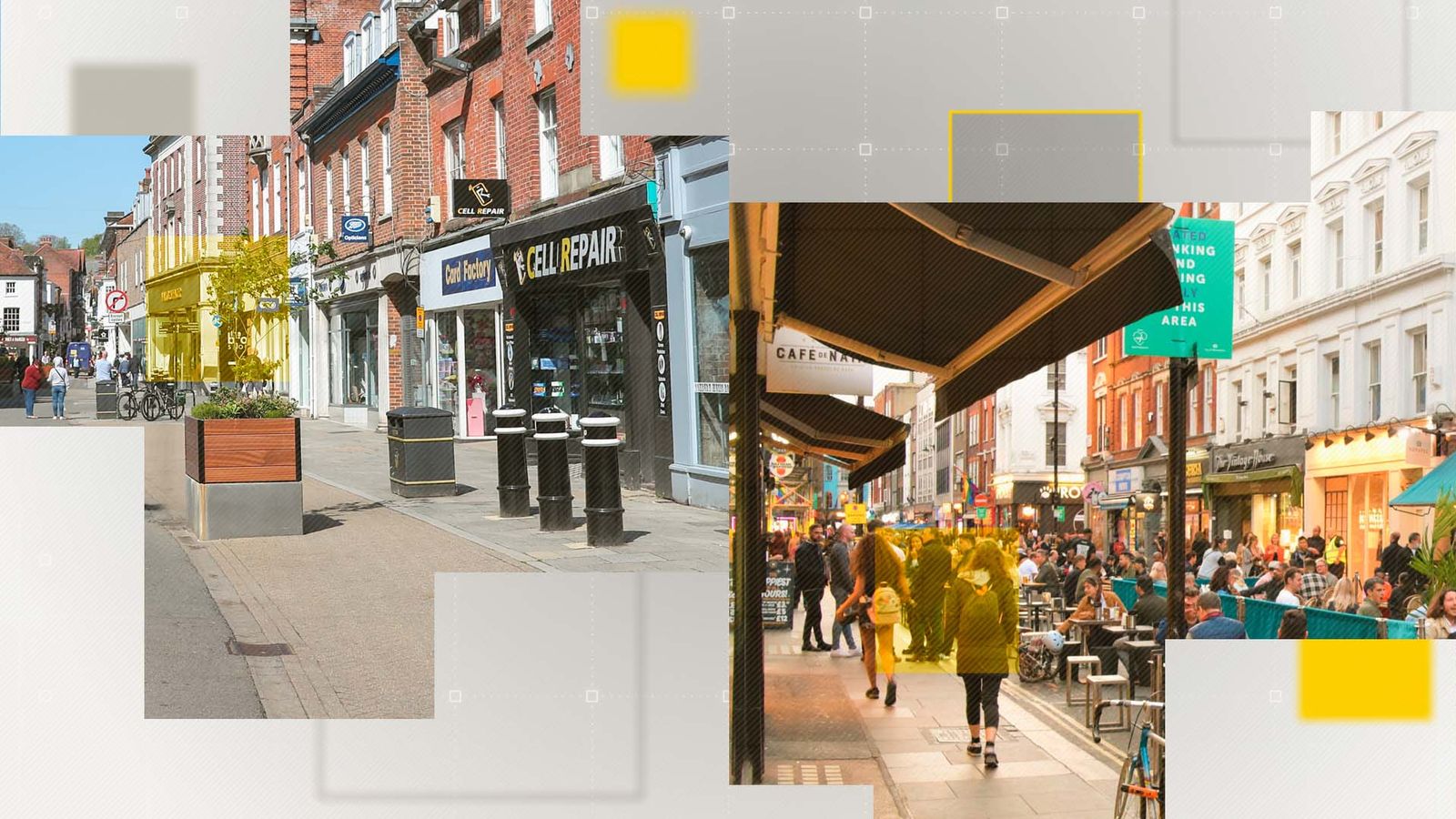As we begin to hit the shops ahead of Christmas, retail sales are back to pre-pandemic levels for the first time since restrictions eased in April.
We are now spending more on items like clothing and furnishings than we were in February 2020, according to real-time credit and debit card data from the Office for National Statistics (ONS).
But Sky News analysis of new data from the Local Data Company suggests there are fewer shops for us to visit – and that the slump of the high street long pre-dated the pandemic.
The decline of the British pub has been well-documented, but since 2016, retail shops have experienced similar closures. The number of retail units in Great Britain has fallen almost 7% over the past decade.
But many of them are being replaced by hospitality outlets. Since 2013, the number of independent cafes and tearooms has risen 10% and the number of chain coffee shops has increased by 7%.
Is cafe culture spreading across the UK?
The fastest growth has been in the East of England and the West Midlands, which now have almost a fifth more cafes and coffee shops as they had in 2013.
The North West has also experienced relatively rapid growth and now has the second highest density of hospitality venues after London at 28 per 100,000 people.
Of course, the capital has long been the cafe-centre of the UK. But while it still has by far the most cafes, coffee shops and tearooms per 100,000 people at almost 43, there’s only been modest growth since 2013.
Professor Michael Kenny, director of the Bennett Institute of Public Policy, says that many places are rebuilding their high streets around social spaces.
“There’s evidence to suggest that the more social opportunities there are, the more likely it is that people will spend more time and – some research suggests – more money in the town centre,” he says.
The government’s High Streets Task Force found that more retail-dependent high streets experienced a larger decline in footfall in the year to June 2020 than those also offering shoppers a range of social and leisure services.
This chimes with a survey by business consultancy CACI, which found that consumers who visit cafes and restaurants spend around 48% more in the surrounding retail businesses.
So, how are the UK’s high streets faring?
Despite the pick up in spending ahead of Christmas, average high-street footfall at the start of November was still only three-quarters of the level it was in early 2020, and as low as 53% in London, according to data from Centre for Cities.
Footfall has returned to normal in only a handful of places like Blackpool and Southend.
The Centre for Cities data compares today’s footfall with average levels in February and March 2020. One reason for the differences between cities could be seasonal variations, such as more people travelling to seaside towns during half-term holidays.
However, Valentine Quinio, an analyst at the Centre for Cities, says that this is unlikely to affect the most recent data.
“Comparing November to February, I would assume there’s not that much difference in terms of seasonality,” she says. “When we look at what’s happened in the first week of November, that’s post-half term and so we’re looking at a normal period.”
Is this helping to level up the rest of the UK?
A comparison of the Centre for Cities’ high street recovery index with pre-pandemic average earnings shows that poorer areas have bounced back quicker.
Ms Quinio says that city size and affluence are key determinants of a high street’s recovery.
“Large cities tend to have a high proportion of office jobs, which can be done from home and that’s of course related to affluence,” she says.
“The fact that people are still reluctant to go back to the office explains why we’re still seeing slower recovery in larger cities, while smaller places rely a bit more on the weekend trade and that’s bounced back.”
But, this will not necessarily help to level up smaller, less affluent areas, as many of them had relatively weak local economies to start with.
“In many of these places, the levelling up challenges that they faced – lack of footfall, lack of consumer spending power, high vacancy rates on the high street – all these issues are still there and still need to be addressed,” she says.
“It’s not the restaurant that attracts the high-skilled jobs, it’s the opposite. That means to address the levelling up agenda we need to invest in skills and we need to make city centres a good place to do business.”
The Data and Forensics team is a multi-skilled unit dedicated to providing transparent journalism from Sky News. We gather, analyse and visualise data to tell data-driven stories. We combine traditional reporting skills with advanced analysis of satellite images, social media and other open source information. Through multimedia storytelling we aim to better explain the world while also showing how our journalism is done.
